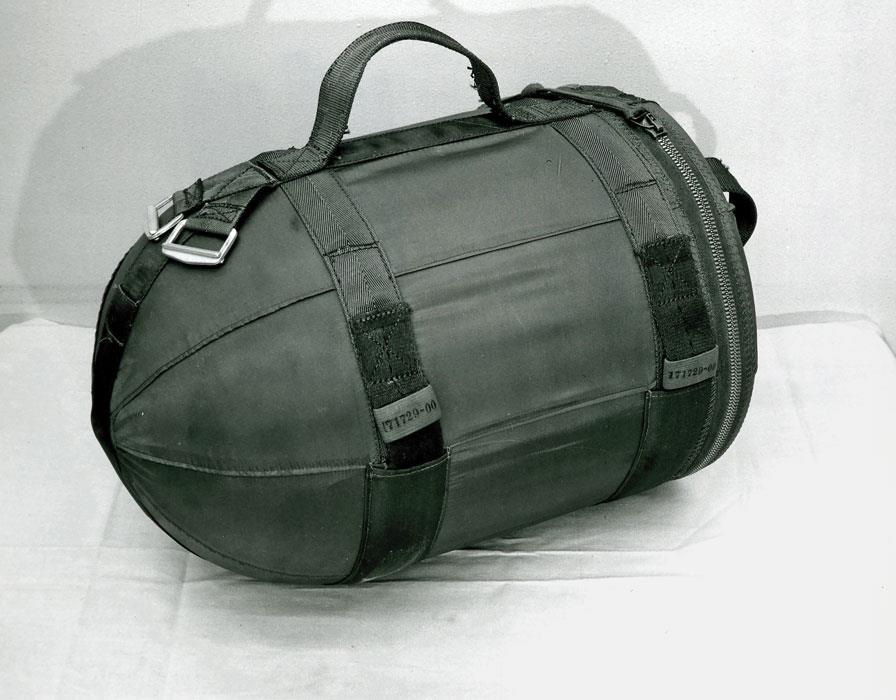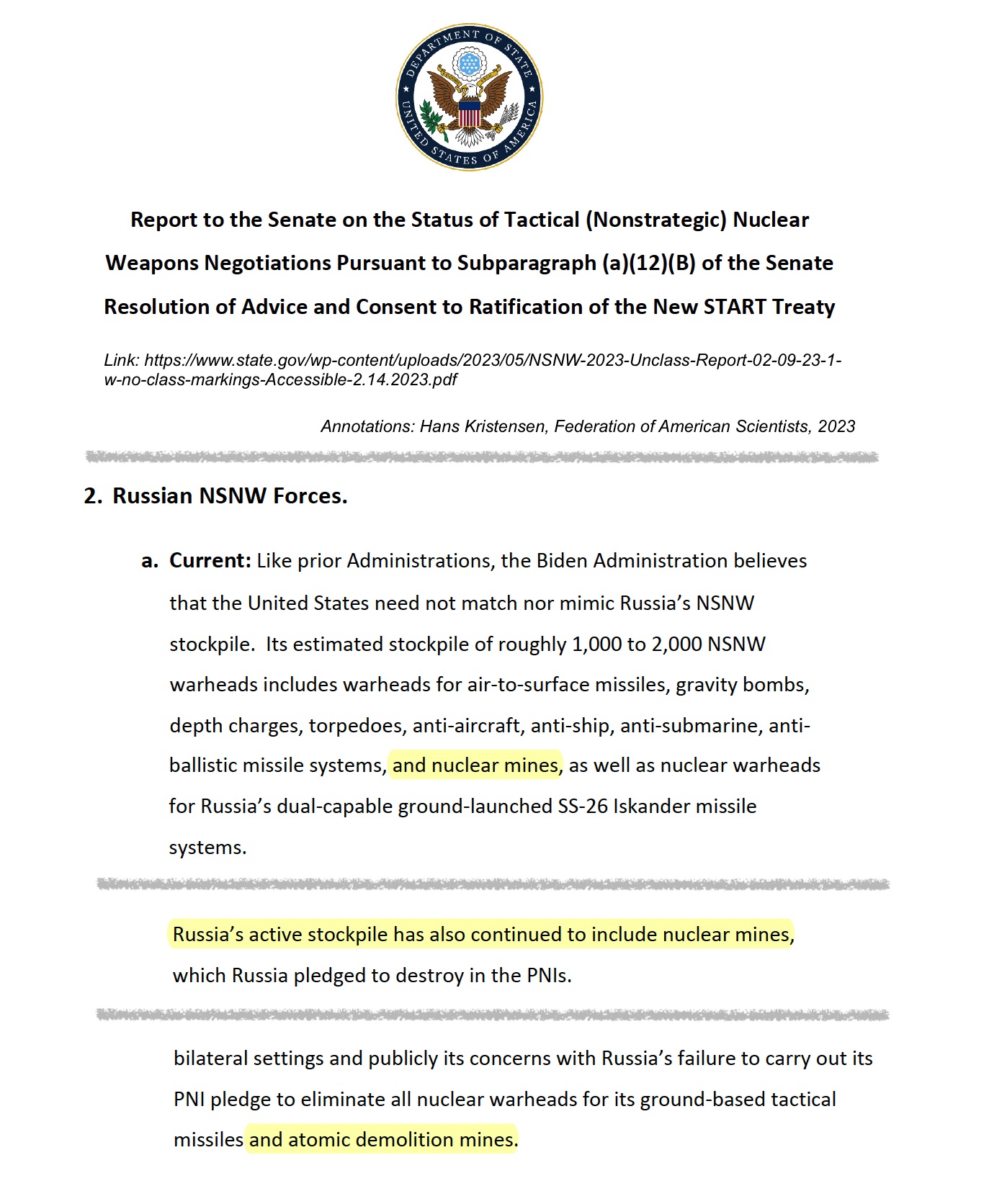
Photos of Russian nuclear “backpacks” or landmines are hard to come by. For illustrative purposes, this is an image of a U.S. Special Atomic Demolition Munition (SADM) in its bag (since retired). The U.S. military possessed nuclear demolition weapons until the 1980s.
Last week, Reuters published a report that said the Wagner group rebellion that sent armed forces hundreds of miles across Russia got near a nuclear weapons storage site: Voronezh-45.
Kyrylo Budanov, the head of Ukraine’s military intelligence, reportedly said that the rebels reached the nuclear base and that their intention was to acquire small Soviet-era nuclear devices in order to “raise the stakes” in their mutiny.

Wagner rebels approached a Russian nuclear weapons storage site near Voronezh to get nuclear “backpacks,” Ukraine’s military intelligence chief claimed. The White House said it could not corroborate the claim.
A White House spokesperson said he could not corroborate the report and added that the United States “had no indication at any point that nuclear weapons or materials were at risk” during the Wagner event.
To help improve transparency on this issue, below we review what U.S. and NATO sources have stated recently about Russian nuclear landmines and non-strategic nuclear forces in general (for a more detailed overview of Russian nuclear forces, see our latest Nuclear Notebook).
Western Statements About Russian Nuclear Landmines
Whether or not the Wagner rebels got to or near a Russian nuclear weapons storage site (or what their intensions were), or whether nuclear weapons potentially stored there were at risk, the episode raises the question if Russia still has nuclear “backpacks” or landmines?
The answer appears to be yes – at least in some form. Recent U.S. Intelligence Community reports refer to them repeatedly, including a U.S. State Department report from 2023. But it is unclear what the status of the Russian landmines is: Are they part of the operational forces or leftovers from the Cold War in queue for dismantlement?
Before examining that question, it is useful to first review what U.S. and NATO sources have said about Russian landmines.
Refences to Soviet-era nuclear landmines can be found in many declassified Intelligence reports. One Central Intelligence Agency assessment from 1981 reported that the Soviet Union “may have introduced nuclear landmines” and a Defense Intelligence Agency guide reportedly listed them. But the wording in these reports were “may have” or “possibly have,” indicating a lower level of confidence. When the Soviet Union broke apart, the issue of “loose nukes” became a prominent concern – especially small weapons that could be easily transported. In a speech at the Stimson Center in 1994, for example, then US Defense Secretary William Perry expressed concern about the danger of loose tactical nuclear weapons in Russia, “such as nuclear artillery shells, land mines and others.” In 1997, Alexander Lebed, a former Russian general and advisor who had been fired by President Yeltsin, claimed Russia had lost track of 100 of 250 suitcase nuclear bombs. The U.S. Government and others questioned the claim and Lebed later withdrew his claim.
These were extraordinary claim for which no evidence was provided and Lebed later withdrew his claim. Yet the rumor that Russia has nuclear landmines has continued to percolate in the public debate and studies. The Trump administration’s Nuclear Posture Review from February 2018 did not list landmines in its overview of Russian non-strategic nuclear weapons. But the following year, one Pentagon official told Congress that the Russian non-strategic nuclear arsenal included “nuclear landmines, and nuclear artillery shells…” NATO appeared to pick up on that in its Annual Report from 2020 that listed both “landmines” and “artillery” (see image below). (It should be noted that neither the U.S. Department of State’s 2022 compliance report nor its 2023 non-strategic nuclear weapons report mentions nuclear artillery.)

NATO in 2020 listed both landmines and artillery in its overview of Russian nuclear forces.
References to Russian nuclear landmines have also appeared frequently in the U.S. State Department’s annual reports on arms control compliance. The report from 2020 listed “atomic demolition mines” as part of Russia’s “active” stockpile of non-strategic nuclear weapons. The 2021 report did not explicitly mention nuclear mines in the active stockpile, and the 2022 report changed the language slightly to the active stockpile “has also continue to include nuclear mines.”
The latest compliance report from 2023 does not include the usual large section on the Presidential Nuclear Initiatives and Russian non-strategic weapons. Instead, that section was moved into a special report on non-strategic nuclear weapons that Congress had requested as part of its approval of the New START treaty. That report, published in February 2023, reiterates that Russia’s “active” non-strategic nuclear stockpile incudes nuclear mines (see image below).

Recent U.S. Intelligence reports refer repeatedly to the existence of Russian nuclear landmines, although it is uncertain how operational they are. The reports do not refer to nuclear artillery.
Russian Non-Strategic Nuclear Weapons
The Trump administration’s Nuclear Posture Review in 2018 estimated that Russia had “up to 2,000” non-strategic nuclear weapons (this was close to the estimate we provided the same year). The NPR estimate was a significant reduction from the “3-5 thousand” Russian warheads listed by Principal Deputy Under Secretary of Defense for Policy James Miller in a briefing to NATO in 2009. Subsequent estimates published by the U.S. Intelligence Community (see above) indicate that the 2018 NPR number was at the high end of an estimated range of 1,000-2,000 warheads. Plotting these numbers from the much higher estimated inventory at the end of the Cold War shows this reduction of the Russian non-strategic nuclear weapons arsenal:

Russia’s stockpile of nuclear warheads for non-strategic forces has decreased significantly since the early-1990s – even during the past 15 years – and is estimated to be down to 1,000-2,000 warheads (including retired warheads awaiting dismantlement).
Interestingly, the U.S. State Department stated in 2022 that the Russian “active stockpile” of 1,000-2,000 non-strategic nuclear warheads included “warheads awaiting dismantlement…” This is curious because in the United States, warheads awaiting dismantlement are not considered “active” or part of an “active stockpile.” Rather, “active” warheads are part of the Department of Defense stockpile that includes both active and inactive warheads. “Active” warheads have all components installed; inactive warheads would need to have those components reinstalled first in order to be able to function.
This suggests that some of the Russian non-strategic warheads that are frequently portrayed in the public debate as part of the arsenal may in fact be retired warheads awaiting dismantlement. Although uncertain, nuclear landmines might be part of that inventory (nuclear artillery shells may be another part of the “awaiting dismantlement” inventory).
In addition to the uncertainty about the status of landmines in the Russian arsenal, advocates for modernization of the U.S. nuclear arsenal have claimed that Russian is expanding its non-strategic nuclear arsenal. Former STRATCOM commander Admiral Charles Richard told Congress in 2020 that “Russia’s overall nuclear stockpile is likely to grow significantly over the next decade – growth driven primarily by a projected increase in Russia’s non-strategic nuclear weapons.” (Emphasis added.)
The basis for that projection is unknown and uncertain. Russia is certainly modernizing its arsenal and fielding more types of weapons that the U.S. intelligence community claims are dual-capable. But how many of those launchers will actually be assigned nuclear warheads is another question. The latest U.S. State Department report acknowledges a Russian increase but cautions that “by how much is uncertain.”
Warhead projections are partially influenced by the expected growth of delivery platform deployments. But just because the number of dual-capable launchers in a weapons category is increasing doesn’t necessarily therefore mean that the number of warheads assigned to that weapons category is also increasing.
In the U.S. nuclear arsenal, for example, not all dual-capable F-15E and F-16 fighter-bombers are assigned nuclear weapons. And just because the F-35A Block 4 upgrade is intended to facilitate integration of nuclear technology, doesn’t therefore mean that all F-35A will be part of the nuclear posture and assigned nuclear weapons.
Simplistic dual-capable launcher counting as a basis for warhead projections could lead to exaggerated numbers.
So, there is much uncertainty about Russian non-strategic nuclear weapons and how the U.S. Intelligence Community makes projections about them. A first step to reducing that uncertainty is to ask questions.
Additional background: Nuclear Notebook: Russian Nuclear Weapons, 2023
This research was carried out with generous contributions from the John D. and Catherine T. MacArthur Foundation, the New-Land Foundation, Ploughshares Fund, the Prospect Hill Foundation, Longview Philanthropy, the Stewart R. Mott Foundation, the Future of Life Institute, Open Philanthropy, and individual donors.
The U.S. should continue its voluntary moratorium on explosive nuclear weapons tests and implement further checks on the president’s ability to call for a resumption of nuclear testing.
This missile launch provides an opportunity to further examine China’s nuclear posture and activities, including the type of missile, how it fits into China’s nuclear modernization, and where it was launched from.
Known as Steadfast Noon, the two-week long exercise involves more than 60 aircraft from 13 countries and more than 2,000 personnel.
Increasing women in leadership roles is important for gender parity and bringing in new perspectives, but it does not guarantee peace.